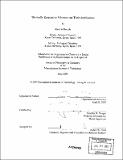Thermally responsive polymers and their applications
Author(s)
Kuroda, Kenichi, 1972-
DownloadFull printable version (4.562Mb)
Other Contributors
Massachusetts Institute of Technology. Dept. of Chemistry.
Advisor
Timothy M. Swager.
Terms of use
Metadata
Show full item recordAbstract
This thesis focuses on development of polymeric materials that can alter their functions according to temperature changes. We chose poly(N-isopropylacrylamide) (polyNIPA) as a platform, which phase-separates from water upon heating. The thermally responsive properties and applications of polyNIPA are introduced in Chapter One. In Chapter Two, we described the synthesis of polyNIPA gels with an imidazole comomoer and examined copper ion adsorption by the swollen (room temperature) and shrunken gels (60⁰C). The data analysis using a Langmuir adsorption isotherm indicates that the imidazole groups form 2:1 and 4:1 complexes with a copper ion in the swollen and shrunken gels, respectively, which suggests that thermal gel swelling and shrinking control the formation of multivalent Cu complexes by changing the distance among imidazole groups. In Chapters Three to Six, the synthesis of polyNIPA-conjugated polymer block copolymers and their applications are described. Non-ionic water-soluble poly(phenylene-ethynylene)s (PPEs) (Chapter Three) were used as conjugated polymer segments in the block copolymers. In a route to synthesis of the block copolymers, atom transfer radical polymerization (ATRP) and nitroxide-mediated radical polymerization (NMRP) of NIPA were developed. Incorporation of ATRP or NMRP initiators to the polymer ends of PPEs and the following polymerizations of NIPA were expected to provide tri-block copolymers with precise structures. The ATRP method produced pure polyNIPA with monodisperse and defined molecular weights (Chapter Four). However, endcapping of PPEs with an ATRP initiator ((α-chloroamide) was not successful due to its instability to PPE polymerization conditions (Chapter Five). (cont.) On the other hand, PPEs could be endcapped with a NMRP initiator (a tert-butyl nitroxide derivative), and the following NMRP of NIPA provided the tri-block copolymers (Chapter Six), phase-separate from aqueous solutions upon heating due to the polyNIPA aggregation. In Chapter Six, we examined fluorescence resonance energy transfer (FRET) between a PPE-polyNIPA block copolymer and Rhodamine B (RhB) bound to polyNIPA. The RhB emission from the polymer precipitates produced by thermally induced phase-separation from the aqueous mixtures increased relative to that from the solutions, which indicates that thermal precipitation brought the PPE and RhB within the F6rster radius of each other and induced FRET between the PPE and RhB.
Description
Thesis (Ph. D.)--Massachusetts Institute of Technology, Dept. of Chemistry, 2003. Vita. Includes bibliographical references.
Date issued
2003Department
Massachusetts Institute of Technology. Department of ChemistryPublisher
Massachusetts Institute of Technology
Keywords
Chemistry.